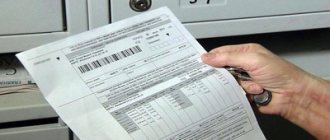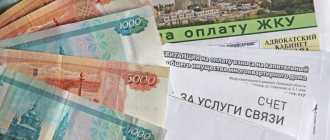Pravozhil.com > Housing and communal services issues > Utilities > Housing and communal services receipts > Standards and calculations for single water supply costs
Payments for utilities make up a significant portion of the expenses of any family budget.
Therefore, the introduction of additional payments, in some cases, causes indignation among payers, since sometimes utility services are of poor quality. In 2013, a payment for one-time tax service appeared in citizens' bills. What it is and what the standards for ODN for water are will be discussed below.
What is included in the ODN?
Premises that are not private property are for general use. Their list is determined by paragraph 1 of Article No. 36 of the Housing Code of the Russian Federation. Common areas include: flights of stairs, landings, halls and corridors, elevators and their shafts, technical floor, attic, roof, basement, land on which the house is located and the area near it, including a children's playground, flower beds, lawns, etc. All this needs maintenance, which is included in the ODN.
Government Decree 345 determines that expenses for general house needs must be paid by apartment owners. This payment is not included in apartment utilities; this is a separate category. The procedure for calculating payment is not affected by the form of management of a residential multi-storey building, as well as the fact of installing individual metering devices in the apartment.
If there are offices, shops, etc. in the house, their owners must also pay ODS.
Researches of judges.
As part of the consideration of case No. A31-1084/2018, the judges stated: the question of whether attics belong to the common property of apartment buildings for calculating payments for electricity consumed for the maintenance of common property should be decided in accordance with Art. 36 Housing Code of the Russian Federation. In addition, it is necessary to find out whether the area of attics is taken into account by the tariff regulatory authority when calculating the standard for the consumption of electrical energy for general house needs.
What information did the tariff regulatory authority take into account?
The Department of Fuel and Energy Complex and Housing and Communal Services of the Kostroma Region, in a letter dated October 30, 2018, indicated that when determining standards for the consumption of utility services for electricity supply for the purpose of maintaining common property in apartment buildings, they sent requests to local self-government bodies and management companies to provide information about the areas premises of the apartment building specified in clause 1, 2, part 1, art. 36 Housing Code of the Russian Federation. The calculation of utility service standards for electricity supply was carried out based on the information provided by municipalities and management companies.
According to the letter dated February 27, 2017, available in the case materials, the company (defendant), in order to determine standards for the consumption of utility services, sent to the department information about the total areas of the premises included in the common property in the apartment building (according to the established form), based on the information specified in the passport MKD. In the form in which the company submitted to the department the information reflected in the technical passports about the total area of the premises included in the common property in the apartment building, there are no separate columns containing data on the area of the attics. This fact, in the opinion of the VBO AS, does not indicate the exclusion of attic area from the total area of premises.
Is attic lighting important?
The presence of attics is confirmed by photographs presented in the case materials and inspection reports of attic spaces in the disputed apartment buildings and was not disputed by the society. The absence of lighting fixtures, as well as the non-use of these common areas (attics), does not exclude the technical possibility of using attics and installing lighting in them.
What information did the management company provide to RSO?
The company, in a letter dated June 28, 2017, provided the RSO (plaintiff) with information about the areas of common areas in the apartment building, including attics, which were subsequently taken into account by the organization when calculating the cost of electricity supplied for general house needs.
Judges' conclusion
A company that has voluntarily assumed obligations to manage residential buildings is obliged to ensure that measures are taken to produce and obtain up-to-date technical documentation for the disputed buildings, including information on the area of premises included in the common property and its composition by type of premises. Failure by the company to fulfill its obligations cannot serve as a basis for exempting it from paying for the supplied resource.
Consequently, there are no grounds for excluding attic areas from the total area of premises that are part of the common property in apartment buildings for the purpose of determining the volume of electricity for general house needs in houses not equipped with a utility supply unit (Resolution of the Supreme Court of the Russian Federation dated May 31, 2019 No. F01-1362/ 2019 in case No. A31-1084/2018).
* * *
When calculating the volume of electricity supplied for the maintenance of common property (common house needs) of houses not equipped with a substation, the area of common property must be taken into account, including the area of attics. Moreover, when establishing standards for the consumption of electrical energy for general household needs, the tariff regulatory authority must also take this area into account. He can receive the relevant information, in particular, from the management company, which must take into account that the area of the attics is included in the total area of the premises that are part of the common property in the apartment building (but only for the purpose of determining the standard for the consumption of electrical energy at the single-unit building).
By the way, the Ministry of Construction notes that there are cases of authorized bodies establishing standards for the consumption of utility services in single-unit residential buildings with violations in terms of incorrect application in calculating the areas of common property in apartment buildings. In this case, the authorized body should immediately take measures to eliminate violations of current legislation, and the State Housing Authority bodies, within the framework of the execution of their powers, should ensure proper control.
Approved by Decree of the Government of the Russian Federation dated May 23, 2006 No. 306.
The transfer of this case to the Judicial Collegium for Economic Disputes of the RF Armed Forces was refused by Ruling of the RF Armed Forces dated November 23, 2018 No. 306-KG18-18936.
The transfer of this case to the Judicial Collegium for Economic Disputes of the Supreme Court of the Russian Federation was refused by Ruling of the Supreme Court of the Russian Federation dated August 19, 2019 No. 301-ES19-12546.
How is payment for ODN calculated?
When establishing the operational level, calculations are made more accurately, because the instruments immediately show how much of this or that resource was used over the past period. Of course, the devices show total consumption, including the amount that was used for private household needs and consumption for the maintenance of public facilities.
The sum of the IPU readings is subtracted from the readings of the common house meter. The remaining volume is divided among apartment owners. The section is performed as follows: the volume of consumption for one square meter is calculated and multiplied by the area of the apartment. The resulting volume is multiplied by the tariff approved in the given region.
Expenses for general household needs in the absence of collective metering devices are accrued according to the standards established by local authorities, using an increasing coefficient (Government Decree No. 345).
The multiplying factor significantly increases the payment amount. It does not apply only if common house metering devices cannot be installed due to lack of technical capabilities.
Ways to reduce the amount
The accrual of ODN is regulated by Government Resolution No. 354 (which entered into force on May 6, 2011). Water heating, heating, supply of hot water to apartments - all these works require significant consumption of thermal energy. And therefore this column in the invoice always consists of a large amount.
But is it possible to somehow reduce the payment without reducing the comfort of living in the house and the quality of its service? There are several ways to save family finances:
- The first step is to install metering devices on the hot water supply. The ideal option is IPU in apartments and general building meters, which will help accurately calculate the hot water consumption for the needs of the entire house. You just need to find out at whose expense the device will be installed.
- It is recommended to insulate the basement and other common areas.
- Replacing old metal pipes with polypropylene ones will also help.
- In order for DHW for general house needs to be calculated correctly and according to the meter, the data from the meter must be transmitted on time. Otherwise, the settlement department will make calculations according to the standards (with subsequent recalculation upon receipt of meter readings).
- Control over the work of the Management Company and resource suppliers is also a method of saving. A representative of the house can check the taken meter readings and check compliance with the monthly accrual.
It should be taken into account that payments, which depend on the number of people living in the apartment, may increase. If an unassigned person lives in an apartment without an IPU for more than 5 days, the Management Company has the right to charge such person payments according to the standards.
For this, it is enough for the House Council to record the fact of residence of such a person and submit the corresponding act to the settlement department.
Installation of a common house meter makes it possible to identify resource leaks. The leakage volume should be subtracted from the total DHW consumption at the ODN. Correcting leakage problems is the responsibility of the service company. In apartment buildings without meters, it is the residents who pay for wasted water losses.
Electricity for ODN in the housing and communal services receipt
Electricity is not only one of the most expensive types of resources, but it is also quite difficult to keep accurate records, since there are regular losses in the network, and their determination is quite complex. Apartment buildings consume a certain amount of electricity every day. Most of it goes to apartments and is used for the household needs of residents. Electricity from one building is the resource that is spent on lighting entrances, corridors, operating surveillance cameras, elevators, intercoms, etc.
If a common house meter is installed in the house, the calculation is carried out according to the above scheme. This is fraught with certain difficulties, since:
- not all residents submit their testimony on time;
- IPU readings were transmitted with errors.
Therefore, in modern homes, automated reading collection is installed. The remaining volume is also divided by the area of the entire house, and then multiplied by the area of each apartment. The volume per living space is multiplied by the standards, and this will be the payment for electricity consumption at one unit.
Odnoklassniki app for phone
Features of working with a personal page:
- Each user of the network has an individual “My Page” and contains personal data posted on it. They are open to viewing by unfamiliar users, even those who are not registered on the network. In this regard, it is recommended to post information about yourself suitable for public review.
- The “Guests” section contains information about who visited the page. But not everyone may be displayed here, since users can view the profile without being displayed in “guests”. Displaying guests is quite rare on Internet resources and is a distinctive feature of this social network.
- Messages, alerts, ratings, discussions and guests are the most used sections. In addition to them, the top panel contains your own name and other data (age, country, city and other information). If your browser doesn't save your passwords even when you click Remember Me, you'll have to enter them every time. But usually passwords are saved, and you just need to click on the saved bookmark and then go to your Odnoklassniki page.
Water and sewerage ODN on the receipt: what is it?
Hot and cold water is used for general house needs. Cold water one is the volume of cold water that is used for cleaning common and service areas, watering lawns and flower beds. DHW ODN is used hot water, which is also taken for wet cleaning, as well as for washing communication systems. These expenses are also calculated using general and individual meters.
Another water-related expense is drainage. Wastewater disposal ODN is the disposal of used water, which is taken for general house needs. Accordingly, the amount indicated in the receipt opposite this column means the accrual of payment for this service. Accrual is carried out according to metering devices or tariffs established by regional authorities.
What are the standards?
According to the above, the calculation of the payment for one-room service is carried out in accordance with the standards in proportion to the area of the owners' residential premises.
Otherwise, a meeting of the owners of residential premises in the apartment building, held in the prescribed manner, is required, during which a decision is made on the payment for the ODPU in fact (based on the testimony of the ODPU), but, as a rule, the difference between the standard and the fact according to the ODPU is not obtained in benefit of homeowners.
The standards for ODN when calculating the amount of the fee are determined at the regional level in accordance with the resolutions of the “Regional Energy Commissions”.
For example: in the Kemerovo region the standards for ODN are as follows:
- Cold water 0.0055 - 0.0398 m3/month per square meter of total area.
- Hot water 0.0079 – 0.0273 m3/month per square meter of total area.
- Water disposal 0.0026 – 0.0546 m3/month per square meter of total area.
What is heating ODN in the receipt?
According to Government Decree No. 354 (05/06/2011), payments for heating are carried out in two main categories:
- consumption by individual private housing;
- the volume of communal resources that is spent on general household services.
ONE heating is the amount of energy spent on heating entrances, parking lots, and office premises. The amount of payment depends on the presence/absence of a general rental agreement, the area of the apartment, the payment period, and the chosen calculation method. There are several methods: according to standards and tariffs. It is beneficial to install collective metering devices, since in this case payments are made only during the heating season. Standards and tariffs are set annually by local authorities; heating costs for heating units are calculated in proportion to the area of the apartments.
Procedure for establishing ODN
General house needs in 2021, as well as in other periods, can be determined by the governing bodies in a particular region. For this purpose, information on expenses incurred for the selected period is collected and analyzed.
For example, when you need to make calculations for 2021, the indicators for 2021 will be taken into account. After analyzing the information received, standards are calculated.
You need to take into account:
- number of residents;
- resource tariffs;
- climate;
- availability of beneficiaries.
Standards for electricity and other resources are determined to compensate for the difference in services consumed in fact and what values are written on metering equipment.
Who installs ODN by region
In an apartment building, standards must be approved. The right to develop these acts is vested in the authorities of the subject. For this reason, such indicators have different expressions in different areas.
For example, in the Irkutsk region, the standards are determined by Order of the Ministry of Housing Policy, Energy and Transport No. 75-mpr of 2021 “On approval of standards for the consumption of utility resources for the purpose of maintaining common property in an apartment building in the Irkutsk region.”
On the territory of the Moscow region, there is a decree of the Ministry of Housing and Communal Services No. 63-RV dated 2021 “On approval of standards for the consumption of utility resources for the purpose of maintaining common property in an apartment building in the territory of the Moscow region”
In the Tomsk region, the Department of Housing and Communal Services and State Housing Supervision in 2021 developed Order No. 20 “On approval of standards for the consumption of utility resources for the purpose of maintaining common property in an apartment building in the Tomsk region.”
In the Krasnodar Territory, the regional energy commission of the department of prices and tariffs in 2021 developed Order No. 3/2017-np “On establishing standards for the consumption of utility resources for the purpose of maintaining common property in an apartment building.”
Procedure for establishing the size of needs
The amount of needs is established at a meeting held by the authorized body. The decision taken is presented in the form of documentation.
The content of this act is as follows:
- the day on which the decision was made;
- number assigned upon registration;
- the basis for the adoption of the document;
- subject for discussion;
- the essence of the formed solution;
- period for implementation of the act;
- list of persons affected by the document.
At the end, the head of the subject authority puts his signature. The deed must be drawn up on a stamp-type form. If a simple A4 sheet is used, then it is necessary to affix a stamp.
Please note: the standards are prescribed in the form of a separate application. The body that made this decision needs to post the decision on the official portal of the Criminal Code
Do increasing coefficients apply to ODN?
Water and other resources are paid for using increased coefficients in a situation where meters are not installed.
In this case, it is necessary to document the possibility of installing metering devices. Charges are based on increased indicators when a citizen could have used accounting equipment, but did not.
Important! In relation to the needs of general house importance, these rules do not apply if this expense item is included in the fee for the maintenance of common property
What happens if you don’t pay ODN?
Many people mistakenly believe that it is not at all necessary to pay the costs of ODN. Of course this is not true! Every citizen is required to pay in full every month. Refusal to pay will result in penalties from the management company. Debt collection can be carried out by bailiffs by court decision. In this case, any property may be confiscated from the citizen, which is then sold to pay off the debt.
The management company is obliged to provide all utilities in full and of proper quality, and property owners, in turn, are obliged to pay for them on time.
What conclusions can we draw from the table of time-current characteristics?
It turns out that the Automatic Switch C16
you can connect a 32 Ampere load for 1-2 minutes.
And this is no longer small - 220V * 32A = 7040 W! That is, 3 kettles at the same time, excluding starting currents
.
For 4-20 seconds, a current of 64 Amps can flow through a 16 Ampere circuit breaker. Agree, not a little! And keep in mind that this is at 30 degrees Celsius. And in cold weather, these currents will increase additionally
!
Our Automatic C16A will turn off - at a current of 128-160 Amps in about a second or less. That is, for a whole second your cable can heat with a current of about 100 Amps! Remember when you installed a C16 machine gun on a 3x1.5 cable - I prefer never to do that.
Please note that circuit breakers from different manufacturers will behave differently. And if they are in different shields, then the temperature in them can also be different
Standards used when paying for housing and utilities
In 2021, the social standard for room area is used to calculate and provide preferences for payment for utilities and heating. These rules apply to situations where legal acts stipulate that benefits are determined taking into account social standards .
The table shows the applied values:
| Number of residents | Norm |
| Citizen lives alone | 33 square meters of total area |
| The family consists of two persons | 42 square |
| Three or more citizens in a family | 18 squares for each |
The specified standard for the size of the premises, taken into account when calculating payments for housing and communal services, was developed by Decree of the Moscow Government No. 306 of 2006 “On approval of the Rules...”.
Water consumption standards in 2021 in the capital
To pay for utility services, the standards set out in the above-mentioned Resolution are applied. In a situation where the premises are equipped with metering devices, their readings are used to calculate payment.
Amounts spent on general house needs are distributed among the owners of all apartments. The size of a specific housing is taken into account in proportion to the total area of the house.
In a situation where the apartment is not equipped with metering devices, the calculation is made on the basis of standards.
Similar rules apply to the calculation of the amount for common property, and it is subject to division between everyone equally.
These provisions are reflected in Government Decree No. 129 of 2015 “On Amendments...”.
Without a meter, payment is charged at an increased rate, which applies to a situation where a citizen is responsible for installing the device in question.
cold water standards are currently applied , presented as 6.935 m3 per person per month. For hot water, the specified norm is 4.745 m3 per citizen. If the volume of consumption is determined without metering devices, the calculated value is subject to increase by the amount of consumption for general household needs.
Important! Decree of the Moscow Government of 2014 No. 75-PP indicates that the total volume of water use in housing not equipped with metering devices cannot be more than the approved standards per person, multiplied by 2.
Norm of consumption of housing and communal services by Muscovites
From the beginning of 2021, established consumption standards in the capital will remain the same. These indicators began to be applied in Moscow in July 2021 and will be valid until July 2021.
Since the summer, tariffs have increased by 7.5% compared to the first half of 2020.
Every year, the Government of the country recommends that regional authorities increase the cost of housing and communal services by at least the percentage typical for inflation.
In addition, subjects have the right to make adjustments to the current values. As a standard, higher standards are set in the capital of the country .
The reason is that every year the cost of work by resource supply companies increases.
According to the Decree of the Moscow Government of January 11, 1994 No. 41 “On the transition to a new payment system...” heating standards are established:
- consumption of thermal energy intended for heating the room - 0.016 Gcal/sq. m;
- water heating - 0.294 Gcal/person.
These indicators are used in a situation where there is no resource metering device installed in the room.
Gas standards
Also in the capital, separate gas standards are applied. They depend on the number of people living in the apartment.
Presented as follows:
- if a citizen lives alone and his living space is equipped with a gas stove, then the standard is 50 m³/person. per month;
- when a family lives in an apartment equipped with a gas stove – 45 m³/person. per month;
- if there is hot water supply in the living room - 8.3 m³/person. per month;
- if the apartment is equipped with a gas stove and water heater - 20.8 m³/person. per month;
- when there is no central water supply and there is a gas stove - 10.4 m³/person. per month.
The specified standards will also apply in a situation where the premises are not equipped with metering devices. When the house is not gasified, and the citizen uses a gas stove, there will be no need to pay for the resource in question.
Sewage standards in the capital
The standard water consumption in Moscow is reflected above, different for hot and cold. In this direction, one should take into account the provisions of Moscow Government Decree No. 41 dated January 11, 1994.
Loading …
Depending on the level of equipment of a particular house with different communication systems, separate standard values are established.
For example, if a residential building is equipped with sewerage, running water, a bathtub, and hot central water supply, the standard for wastewater disposal is 11.68 m³ per person per month.
In this case, the standard per citizen for cold water is 6.935, for hot water - 4.745.
If the room has sewerage, running water and a bath with gas-type heaters:
- cold water supply - 9.86 m3 per citizen;
- water removal – 9.86.
If a water supply system with gas-type heaters for baths and sewers is installed in an apartment building, then the standards change. In this case, drainage and hot water supply is 9.49 m3 per person.
Please note: when a hotel-type residential building is considered, which is equipped with running water, hot water, and gas, the standards for wastewater disposal are 7.31 m3 per person, for cold water supply the figures are 4.386, for hot water supply - 2.924.
In a situation where an apartment building has a gas pipeline, sewerage, water supply, but no baths, the standard for water disposal is 4.57 m3 per person, for cold water supply - 4.57 m3. In addition, the permissible values are established relative to the personal plot policy, which are equal to 0.16 m3. This rule is valid from May to September.
Electricity consumption standards in capitals
For electricity, separate regulations also apply. These values also differ depending on what systems the MKD is equipped with.
Indicators used:
- if the apartment has a gas stove - 100 kW per person;
- availability of electric stove – 150 kW;
- when a water heater is installed - 120 kW;
- if both a water heater and an electric stove are used - 170 kW.
These values increase depending on how many citizens live in the apartment. However, the standards are reduced in proportion to the number of people living in the premises.
Using multiplying factors
The consumption standards for heat, water, gas and electrical energy are increased by a factor in a situation where a citizen should have equipped the premises with metering devices, but did not do so.
In this case, the provisions of Decree of the Government of the Russian Federation of April 16, 2013 No. 344 are applied, which specifies increasing values for calculating the amount of payment for housing and communal services.
They are presented this way:
- at the beginning of 2021 – 1.7;
- from 2021 – 1.8;
- at the beginning of 2021 – 1.9.
As a result, the citizen has to pay the increased cost of the resources provided.
Thus, standards for consumption of services in the housing and communal services sector within the capital are controlled by the executive system. The established values change every year.
Household needs water
ODN February 23, 2016
The emergence of the concept of one-time use or general household needs has puzzled many, since it is difficult to immediately understand what it is and how to calculate one-time use for water and utilities at new tariffs. Thanks to this article and this site, you can find answers to frequently asked questions and understand what’s what in the new receipt for payment of housing and communal services and how to make calculations in order to make the payment correctly.
The information presented will be relevant in 2021, 2021, 2021 and other years, since data for the cities of Novosibirsk, Moscow, Omsk, Moscow region, Perm, St. Petersburg, Chelyabinsk, Kaliningrad and other cities in Russia and Ukraine are constantly updated. It is also worth noting the fact that the new law has not been repealed, although some media outlets wrote about it, but the price actually increases for all services.
What is ODN for water in housing and communal services?
Utility resources “come” to multi-apartment residential buildings, some of which are sent to the residents’ apartments, and the rest are spent on the house itself and common property, which is called ODN in housing and communal services.
Government decree number 354 states that each apartment owner must pay for the services he consumes and those for the entire house, for which calculation formulas are used, which will be discussed later in this article.
What is included in general house water needs?
What is included in the ODN for cold water according to the law? This includes: - washing the landing and cleaning the garbage chute using water; - watering the lawn, caring for the front garden; - washing communications;
- loss of water supply systems inside the house.
What is included in the ODN for cold water according to Resolution 354? This includes: - discharge of water in the risers of the house during the repair of batteries and heating systems; - pressure testing of the heating system after repair work; - preparation for the new heating season, in which hot water is used for process flow;
- loss of water in the intra-house network.
The methodology for calculating ODN for hot and cold water in an apartment building will be adjusted for the used water meters (common building water meters). The question of whether one is installed or at each entrance will be considered later.
General house needs for hot water supply and cold water
Consumption of hot water, as indicated by government decree No. 344 dated April 16, 2013, and other water costs will be included in the general principle of calculating resources for each consumer.
Most often, the calculations made for ODN for water will be distributed to each of the personal accounts in the house using the principle of proportionality to the area. At the same time, the personal account is an apartment or non-residential premises, since all of them will be included in the costs of the entire house.
Housing and communal services standards for hot and cold water are determined for each region separately
Calculation of ODN for water in the absence of common house metering devices
If we talk about the general case, then the following formula for cold and hot water is used for calculation:
Nodn = 0.09 x K/ Soi (cubic meter/square meter per month)
The value of Nodn is a standard for utility services for beneficiaries and those who do not have benefits for water supply. The figure 0.09 represents the consumption of water resources per 1 resident, and the K value shows the number of residents of the entire house. The parameter Soi is understood as the total area of all rooms in the house.
Another ODN formula:
Vodn = standard * Sodn
In this case, Vodn represents the value of the volume for all accounts, and Sodn refers only to the area that is included in the common property, that is, we are talking about common areas. The obtained value according to the second formula must be distributed among each resident, including taking into account non-residential premises, for example, shops located inside a residential building.
Calculation of ODN for water in the presence of communal apartment metering devices
In this situation the following calculation applies:
Vdn = Vhouse – Vaccount – Vnorm – Vdeduction
By the value of Vdn, it is customary to understand the volume of all accounts for distribution according to household needs, and Vhouse is consumption according to a meter installed for the entire house.
The value of Vaccount is calculated as the sum of the volumes according to the indicators of each apartment meter, and Vnorm is the total standards in those cases where there is no meter.
The value of Vdeduction is understood as a deduction option that is associated with additional services.
Water disposal for general house needs
If you look at the new law and its changes, you can understand that for the presence of metering devices in a residential premises, you have to pay less in comparison with the previous period, since payment in excess of the norm does not mean to come from the owner of the residential property, but will go to the one who will be the service provider. But there is an exception associated with the supplier in the person of a company that will engage in similar activities and will not give permission for such benefits.
Consumption and payment for water for general house needs
Water supply has ambiguous interpretations, which affects the calculation formulas and the final bill presented to the consumer.
If we talk about the new rules introduced on June 1, 2013, then there is a proposed difference in the volume of individual heating and that provided by the supplier, which suits almost everyone, although the bill requires revision, since today’s options are those those who do not have a meter and the residents of an apartment building for whom it was installed are equal in the amounts of payments for deductions for the entire house, and the difference will only be in the case of assessments for individual apartment use.
How not to pay one tax for water legally and legally
Is it possible not to pay utility bills? Payment cannot be canceled completely, but it is possible to save money even without benefits.
To begin with, it is worth eliminating errors and cheating of meters by representatives of the management company, which can be easily done by proposing candidates for the position of controllers from the entire building, who are selected from among the residents.
They are given the right to check the readings taken by representatives of the management company and make sure that all values correspond to real consumption, and subsequent calculations are carried out without errors. An equally useful innovation is the installation of a control unit, which provides the greatest savings for each resident.
Common house water meters
Such water meters will be in demand in the case when the HOA or management company will deal with payments for all residents. A general house water meter has certain installation rules and costs for such work, and in its absence, new consumption standards may be taken into account.
Who pays for the installation? At whose expense will the installation be carried out? In this case, the money is paid by the homeowners, since it is only in their interests to start paying less for housing and communal services.
It is noteworthy that such installations are able to detect all types of leaks and subtract them from the total value, which gives real consumption figures that need to be paid, and the residents of the house will not pay for the remaining losses, but this is done by everyone who has not installed a meter for the entire house.
Can ODN be greater than individual consumption?
If in the receipt for electricity the amount of payment for the electricity supply of common house needs is above the norm (exceeds individual consumption), then this may indicate the theft of electricity, and specifically an unauthorized connection to the electricity supply, bypassing the installed meter.
Persons who are involved in the theft of electricity must bear the responsibility established by law.
Decoding
The abbreviation ODN stands for “common house needs” of an apartment building (also called MKD in regulations). According to Article 36 of the Housing Code of the Russian Federation (LC RF), the owners of premises in apartment buildings own not only their apartments/storage rooms/parking spaces, but also common property (by the right of shared ownership).
Common property means an extensive list, namely:
- landings and stairs;
- elevators;
- corridors;
- technical floors;
- MKD roof;
- attics and basements;
- all mechanical, electrical, plumbing and other equipment serving more than one premises;
- the land plot on which the apartment building is located;
- all objects located on this land plot and intended for maintenance, operation and improvement of the apartment building, including landscaping and landscaping elements, etc.
ODN represent utilities consumed for the purpose of servicing the above-mentioned common property of the house.











